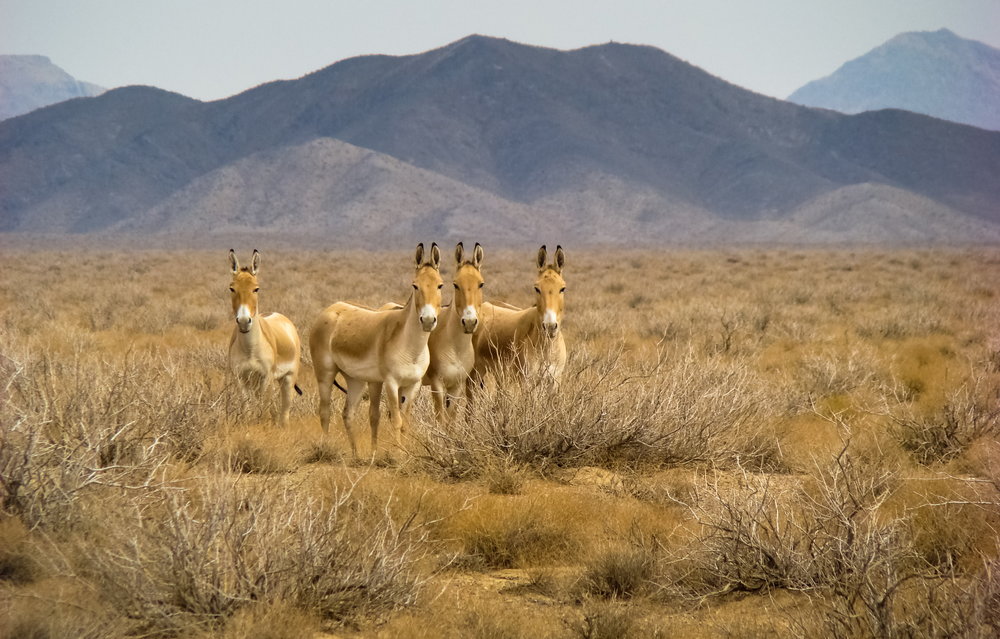Onagers on the verge of extinction

As a species on the verge of extinction, the following text provides an introduction to “Onagers”, the unusual-looking Persian wild ass which is called so for its peculiar appearance.
Typically, an onager is grey-brown to yellow color above with a black dorsal stripe running from the mane to the tail. The lower flanks and underparts are white. The animals prefer bleak and steppe landscapes such as Touran National Park (South corner of Tehran-Mashhad road between Biararjmand and Sadrabad).
Going on safari is not the only way to see onagers from near. Even in megacities like Tehran, the animals are kept in zoos. A small number of onagers are now living in Tehran Zoo, which is located kilometer fourth of Tehran-Karaj Expressway. This complex gives first-hand experience of seeing the subspecies in the wild.
Hardy and adaptable
Today small populations of Onagers are found in Touran National Park as mentioned before. Bahrame-e Gur Protected Area (Fars Province) and Sarakhs in Khorasan province are two famous habitats of the subspecies in Iran. Sadly, onager populations have shrunk dramatically because of hunting as well as overgrazing by domestic animals such as sheep, goats and camels. Onagers are hardy animals and can survive in bleak desert areas.
Knowing magnificent subspecies
Currently, there are five generally recognized subspecies of the Asiatic wild ass:
* Equus hemionus hemionus which lives in the Mongolian Khulan (North of Mongolia)
* Equus hemionus khur in India
* Equus hemionus kulan in Turkmenistan. This subspecies has been reintroduced to Kazakhstan, Uzbekistan and Ukraine
* Equus hemionus onager in Iran
* Equus hemionus hemippus which is an extinct subspecies in Syria. This subspecies once ranged from eastern shore of Mediterranean Sea to Arabian Peninsula.
Onagers disappeared from western Iran in the 1930s, but were still widespread in central and eastern arid and semi-arid plains until the 1950s. By the 1980s only four subpopulations were left. However, no reports of the animals have been heard of in Kavir National Park since 1986 and none in recent years from the once trans-boundary Sarakhs subpopulation along the border to Turkmenistan.
Currently, the Persian wild ass or Equus hemionus onager in Iran are seen in two autochthonous subpopulations: 1) Touran protected area network and 2) Bahram-e-Gur protected area with Qatruiyeh National Park. In addition, there is a small reintroduced subpopulation in Kalmand Protected Area.
Efforts to restore small populations
Onagers have been hunted by humans in the past for their flesh and hide. Legend has it that onager hunting was the favorite game of Sassanid King Bahram V. (420-438 AD). He is said to have died by sinking into a swamp in his impulsiveness to hunt down an onager.
In 1971, Equus hemionus onager became a protected species in Iran, whose hunting was prohibited year-round. It seems that the legislation has failed to save the dwindling herds because growing human populations began to fence off lands for cultivation. Equus hemionus onager has no natural predators other than human beings!
Excessive hunting, competition with domestic stock, and inbreeding have inflicted heavy causalities on onager populations in Iran, putting the species on the verge of extinction. Onagers have a well-developed sense of smell and can detect potential predators such as humans from a far distance. However, human interference outdo than the animals’ keen senses.
While the Bahram-e-Gur subpopulation has shown a positive trend in recent years, but it is assumed this trend may not continue as threats still persist. The second subpopulation in the Touran protected area seems to have severely decreased to 145 animals and may well be lost within the next few years (two generations) without urgent conservation actions.
Fortunately, there are some in captivity. Onagers are famous to have a bad temperament, making them unsuitable as workaday domestic animals. Persian wild ass kept as a rarity in Zoos or even in some other protected areas by Department of Environment (DoE).
International Union for Conservation of Nature and Natural Resources (IUCN) has estimated that with the current decline rate of 28 percent, there will remain only 144 onagers over the last three generations. Even so, a comprehensive program might prove more practicable in the long run than captive breeding, which is the only other way of ensuring the long-term survival of the Persian Wild ass.
Photo by Hamed Tizrouyan
